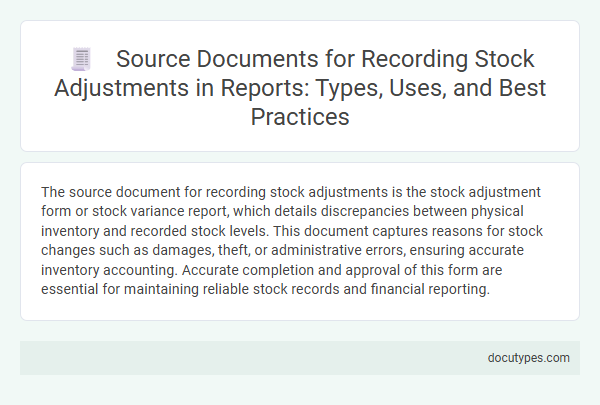The source document for recording stock adjustments is the stock adjustment form or stock variance report, which details discrepancies between physical inventory and recorded stock levels. This document captures reasons for stock changes such as damages, theft, or administrative errors, ensuring accurate inventory accounting. Accurate completion and approval of this form are essential for maintaining reliable stock records and financial reporting.
Introduction to Source Documents for Stock Adjustments
| Introduction to Source Documents for Stock Adjustments | |
|---|---|
| Definition | Source documents for stock adjustments are original records that provide proof and details of changes made to inventory levels. |
| Purpose | They serve as the primary evidence for recording increases or decreases in stock quantities due to various reasons such as damage, theft, or stock takes. |
| Examples of Source Documents | Stock adjustment forms, inventory count sheets, supplier credit notes, and stock transfer records. |
| Importance | Ensuring accuracy in stock records helps maintain financial integrity and supports audits. Your business relies on these documents to track inventory changes reliably. |
| Role in Accounting | They authorize entries in inventory accounts and facilitate reconciliation between physical stock and ledger balances. |
Importance of Accurate Stock Adjustment Records
The source document for recording stock adjustments is typically the stock adjustment form or inventory discrepancy report. This document provides a detailed account of changes in stock levels due to reasons such as damage, theft, or inventory counting errors.
Accurate stock adjustment records are crucial for maintaining inventory integrity and financial accuracy. They ensure reliable data for inventory management systems, supporting better decision-making and preventing stockouts or overstocking. You rely on these precise records to protect your business from financial discrepancies and operational inefficiencies.
Types of Source Documents in Stock Reporting
The source document for recording stock adjustments is essential in maintaining accurate inventory records. These documents provide the foundational data needed to update stock levels after discrepancies are found.
- Stock Adjustment Voucher - A formal document detailing the changes made to inventory quantities due to damage, loss, or errors in counting.
- Goods Receipt Note - Records incoming stock and is used to verify and adjust inventory upon receipt of goods.
- Stock Transfer Note - Documents the movement of stock between different locations or departments, supporting stock adjustments during transfers.
Your accurate recording of stock adjustments depends on properly using and filing these source documents.
Stock Adjustment Forms: Definition and Usage
Stock adjustment forms serve as the primary source documents for recording changes in inventory levels. These forms capture detailed information about stock increases or decreases due to reasons such as damage, theft, or errors in counting.
Using stock adjustment forms ensures accuracy and accountability in inventory management processes. You can track and verify stock movements efficiently, maintaining up-to-date records for financial and operational reporting.
Goods Receipt Notes: Tracking Incoming Inventory
Goods Receipt Notes (GRNs) serve as the primary source document for recording stock adjustments related to incoming inventory. They provide an accurate record of goods received, ensuring proper inventory tracking and accountability.
- Verification of Deliveries - GRNs confirm that the quantities and descriptions of received goods match purchase orders and supplier invoices.
- Inventory Update - They enable real-time adjustment of stock levels in inventory management systems immediately upon receipt.
- Audit Trail - GRNs create a documented accountability trail that supports transparent inventory audits and financial reporting.
Stock Issue Slips: Documenting Outflows
What is the source document used to record stock adjustments related to stock outflows?
The stock issue slip serves as the primary document for documenting stock outflows. It provides detailed information on the quantity and description of items issued from inventory, ensuring accurate stock adjustment records.
Adjustment Memos for Discrepancy Management
The source document for recording stock adjustments is primarily the Adjustment Memo, essential for managing inventory discrepancies. This memo provides detailed information required to update stock records accurately.
- Adjustment Memo Creation - It is generated when discrepancies between actual stock and recorded inventory are identified.
- Discrepancy Details - The memo includes specifics such as item codes, quantities adjusted, and reasons for the stock variance.
- Inventory Record Update - Your stock ledger is updated based on the Adjustment Memo to reflect accurate inventory levels.
Electronic vs. Manual Source Documents
The source document for recording stock adjustments is critical for accurate inventory management and audit trails. Electronic source documents, such as barcode scans and digital inventory reports, streamline data entry and reduce errors through automation and real-time updates. Manual source documents, including physical stock count sheets or adjustment forms, require manual entry and verification but remain essential in environments lacking digital infrastructure or during system downtime.
Best Practices for Handling Stock Adjustment Documents
The source document for recording stock adjustments is typically the stock adjustment form or physical inventory count sheet. This document captures details such as item descriptions, quantities adjusted, reasons for adjustments, and authorization signatures. Best practices include ensuring accuracy through regular audits, obtaining proper approvals, and maintaining clear documentation for audit trails.
What Is the Source Document for Recording Stock Adjustments? Infographic

